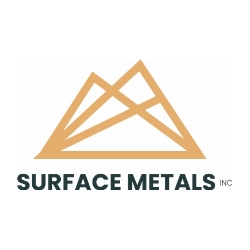Surface Metals Confirms 2026 Drilling Campaign and PEA as Dual Commodity Consolidation Creates Survivor Advantage

Surface Metals advances Nevada gold drilling alongside 300k+ ton LCE lithium resource, capturing dual commodity exposure as institutions forecast $5k gold.
- Surface Metals has strategically positioned itself with dual-commodity exposure through its April 2025 acquisition of the Cimarron Gold Project in Nevada's Walker Lane trend whilst maintaining a diversified lithium portfolio including a 300,000+ ton LCE resource at Clayton Valley, adjacent to Albemarle's producing Silver Peak operation.
- CEO Steve Hanson's meetings in New York recently revealed strong institutional appetite for junior and mid-cap mining opportunities, with major banks including JP Morgan, Goldman Sachs, UBS, Deutsche Bank, and HSBC forecasting gold prices reaching $5,000 per ounce in 2026 driven by central bank accumulation, interest rate dynamics, and geopolitical tensions.
- The company plans to commence phase one drilling at Cimarron in 2026 targeting confirmation of historical high-grade intercepts from Newmont and Echo Bay's 1980s-1990s work, validation of a non-43-101 compliant resource, and expansion towards a one-million-ounce target, with shallow oxide mineralisation suggesting potential heap leach processing economics.
- Surface Metals demonstrates capital efficiency through partnership structures including Snow Lake Resources earning into its Manitoba pegmatite project, active joint venture discussions for Fish Lake Valley (contiguous to Ioneer's Rhyolite Ridge project with Ford, Toyota, and Panasonic off-takes), and advancement of Clayton Valley towards a 2026 preliminary economic assessment utilising direct lithium extraction technology validated by neighbouring SLB's demonstration facility.
- The company has survived lithium sector consolidation, maintaining its project portfolio, and reducing operational costs whilst positioned to benefit from both gold's supply deficit (as major producers exhaust high-grade reserves) and lithium's recovery momentum as institutional interest returns to the sector.
In a market environment characterised by record gold prices and a nascent lithium recovery, Surface Metals Inc. (CSE: SUR) has positioned itself with a dual-commodity strategy that provides exposure to both precious metals momentum and the long-term electrification thesis. Following recent meetings with institutional investors on Wall Street and Bay Street, President and CEO Steve Hanson reports renewed appetite for junior and mid-cap mining opportunities, particularly amongst companies with high-quality projects in tier-one jurisdictions.
The company's April 2025 acquisition of the Cimarron Gold Project in Nevada represents a strategic pivot that addresses near-term market opportunities whilst maintaining significant optionality through its lithium portfolio. This approach reflects pragmatic capital allocation in a sector where timing and jurisdiction remain critical determinants of success.
Institutional Perspective: Wall Street's Gold Thesis
Hanson's recent institutional roadshow revealed substantive conviction amongst major financial institutions regarding gold's trajectory.
"Gold obviously has been a major theme for 2025," Hanson noted. "Gold has hit all-time highs. It continues to trade above $4,000. Most of the major banks in New York are calling for $5,000 gold in 2026 including JP Morgan, Goldman Sachs, and even some of the world banks, whether it be UBS or Deutsche Bank, HSBC and others are calling for double-digit growth in the gold price in 2026."
The fundamental drivers underpinning these forecasts extend beyond typical cyclical factors. Central bank accumulation continues at historically elevated levels, with Poland, India, and France amongst nations building reserves. Simultaneously, interest rate dynamics, treasury pricing pressures, and persistent geopolitical tensions are reinforcing gold's role as a monetary hedge and safe-haven asset.
For junior mining companies, this macro environment translates into tangible benefits.
"It certainly allows us in this kind of environment to potentially access greater amounts of capital," Hanson explained. "Broadly with the meetings that I had, they are looking for names to invest in new names to invest in, not just at the large cap level, but at the midcap and small cap level as well."
Beyond capital access, the elevated gold price environment is catalyzing increased merger and acquisition activity and joint venture discussions - creating multiple pathways for value realization beyond traditional mine development timelines.
Supply Dynamics: The Coming Production Gap
An often-overlooked element of the current gold market relates to supply constraints that may exacerbate price pressure. Hanson highlighted a concerning trend in global production:
"There have not been that many gold mines that have gone into production in the last few years. There are very few. Most of the existing mines have high-graded the higher grade ore. They're into medium to lower grade ore now, so we're going to have a supply crunch here actually that will potentially drive prices, too."
This observation underscores a structural challenge facing the gold sector. As major producers exhaust higher-grade reserves and new large-scale discoveries remain scarce, the industry faces a genuine supply deficit that financial engineering cannot address. The solution requires new discoveries, successful permitting processes, and ultimate production - a multi-year timeline that favours early-stage projects with clear paths to development.
"There's a need for us to find new and make new discoveries for gold and continue to go through the permitting process and ultimately get into production," Hanson emphasised. "Those are all good signs whether you're a junior, or a developer, or mid-size company."
Cimarron Gold Project: Historical Pedigree in Tier-One Jurisdiction
Surface Metals' acquisition of the Cimarron project brings immediate technical merit based on extensive historical work. Located in Nevada's prolific Walker Lane trend approximately 35 kilometres south of Kinross's Round Mountain mine, the project benefits from work conducted by Newmont and Echo Bay (subsequently Kinross) during the late 1980s and early 1990s.
"What attracted me to it was Newmont and Echo Bay which became Kinross worked on this project back in the late 80s and early 90s," Hanson recounted. "So there was a drill database, there was some high-grade intercepts. There was mineralization with high grade all the way to surface relatively shallow mineralization, and it was open in a number of different directions and there was a small resource."
The project area retains physical evidence of historical mining activity dating to the 1920s and 1930s, including mine workings, buildings, adits, and shafts. More significantly, Surface Metals has undertaken comprehensive work to digitize and enhance the historical database, creating three-dimensional models and new geological sections that provide contemporary understanding of the mineralization.
This preparatory work positions the company to commence drilling with clear targeting rationale rather than speculative exploration. The presence of high-grade intercepts extending to surface suggests potential for near-surface oxide mineralization amenable to heap leach processing - a lower-cost, lower-complexity development pathway particularly relevant for junior companies.
Phase One Drill Programme: Confirmation and Discovery Objectives
Surface Metals plans to initiate a phase one drill programme at Cimarron in 2026 following completion of technical planning and capital raising. The programme encompasses multiple objectives designed to validate historical work whilst advancing the project towards a compliant resource estimate.
"Number one is let's confirm these high-grade intercepts that were found back in the 80s and 90s. Let's confirm this non-43-101 resource that's there and potentially there's more ounces there too. And then we want to make additional discoveries. There's mineralisation that extends in multiple directions and in depth. And we want to continue to grow this resource over time," Hanson outlined.
The drilling strategy will blend confirmation work - including twinning selected historical holes - with new drilling targeting areas where mineralisation remains open. Critically, numerous shallow historical holes terminated in mineralisation, suggesting potential for expanded tonnage at depth.
"There'll be a blend of those to get to 43-101 compliance, but there's going to be some new holes there too into infield drilling stepping out as well," Hanson explained. "There are some very, very shallow holes drilled back in the 80s and 90s that ended in gold and ended in mineralization. Well, maybe we can drill a little bit deeper and continue into mineralisation."
The company's target extends well beyond the historical non-compliant resource. "We really would like to get to sometime down the road a million-ounce target", Hanson noted, framing the phase one programme as the initial step in a systematic approach to resource expansion rather than mere historical validation.
Infrastructure and Permitting Advantages
Cimarron benefits from Nevada's established mining infrastructure and relatively streamlined permitting environment for exploration activities. The project sits approximately 45 minutes from the mining town of Tonopah, accessible via existing roads with year-round operability.
From a regulatory perspective, Hanson expects standard timelines:
"In 90 days in my experience, we can get a drill permit with a notice of intent. We know most of the drilling contractors down there and with access to people and equipment and so forth. So 90 days is typical up to maybe 120 days."
The presence of existing drill pads reduces site preparation requirements whilst new pads can be established as needed. More broadly, Nevada maintains its position amongst the world's premier mining jurisdictions - a consideration of increasing importance as geopolitical factors influence investment decisions.
Interview with Stephen Hanson, President & CEO of Surface Metals
Lithium Portfolio:
Clayton Valley Brine Project
Whilst Cimarron addresses near-term market opportunities, Surface Metals maintains a substantial lithium portfolio spanning three projects across different geological settings and development stages. This diversification provides exposure to various lithium extraction methodologies and partnership structures.
The company's Clayton Valley project represents its most advanced lithium asset, featuring an inferred resource exceeding 300,000 tons of lithium carbonate equivalent (LCE). Located immediately northwest of Albemarle's Silver Peak operation - North America's only operating lithium brine facility - the project benefits from geographical proximity to established production.
Hanson emphasized the geological continuity:
"We are contiguous to the northwest of Albemarle. I can throw a baseball or kick a football over the berm into their evaporation ponds [...] Our brine's very similar to our neighbour, so we have large players right in our neighbourhood that have brine that is conducive to producing lithium."
Surface Metals achieved its resource estimate following a rapid 2-and-a-half year progression from greenfield exploration to maiden resource - demonstrating technical execution capability. The company now targets a preliminary economic assessment (PEA) for 2026, with ongoing evaluation of direct lithium extraction (DLE) technology as an alternative to traditional evaporation pond approaches. DLE technology offers significant advantages including faster processing times, higher recovery rates, and reduced surface footprint.
"This is new technology that allows you to pump brine to surface, put it through a plant, and get lithium out the other side. Traditional lithium has gone to evaporation ponds. It's taken a couple years to evaporate. This is a much faster process with better recovery," Hanson explained.
Importantly, neighbouring operator SLB (formerly Schlumberger) established a DLE demonstration facility in Clayton Valley during 2025, successfully producing lithium from brine with similar chemistry to Surface Metals' resource. This de-risks technology application whilst potentially eliminating the need for company-specific pilot facilities.
Fish Lake Valley Claystone Project
Surface Metals' Fish Lake Valley project represents exposure to sedimentary claystone lithium mineralisation - a distinct geological setting from brine deposits. The project sits contiguous to Ioneer's Rhyolite Ridge project, which has secured offtake agreements with Ford, Toyota, and Panasonic and plans construction commencement in 2026 with US government backing.
"We are their western neighbour. We're contiguous to their ground and their resource is just up the road. In fact, their access road goes right through our project area," Hanson explained. "We have high-grade lithium on surface. We've done geophysics there. We have benches of lithium that we believe are highly probable with a drill programme as it's never been drilled."
The company actively seeks a joint venture partner to fund initial drilling, consistent with its capital-efficient approach. The proximity to Ioneer's permitted project with established infrastructure and offtake arrangements provides significant development pathway optionality.
Institutional Interest in Lithium Persists
Despite gold's prominence in current market discourse, Hanson reports sustained institutional interest in lithium assets - reflecting growing recognition of the sector's recovery from 2023-2024 lows.
"Interesting enough last week, there was a lot of interest in our lithium projects. I wouldn't say I was surprised, but it was really good to hear that lithium still continues to be front of mind. We've obviously had a resurgence in interest in the producers and some of the developers as well as in the commodity over the last few months."
This observation aligns with broader market trends showing lithium prices stabilising and selective investment returning to the sector. The company's decision to maintain and advance lithium assets through the downturn positions it to capture recovery momentum whilst many competitors have ceased operations or pivoted entirely away from the commodity.
Capital Efficiency and Sector Consolidation
Surface Metals' approach to capital allocation reflects lessons from lithium's rapid boom-bust cycle.
"When I started this company, there was 30 to 40 lithium companies globally. It grew to, I don't know, around 200-250. Everybody and their cousin was a lithium company or a battery metals company. Now, we're back down to probably 60 maybe," Hanson observed.
The company has materially reduced operating costs whilst maintaining project advancement through partnership structures and targeted technical work that avoids dilutive capital raises during unfavourable market conditions.
"We've cut costs, although our burn rate wasn't significantly high, but we've even cut that further over the last year and a half," Hanson noted.
This discipline extends to project-level decision making. The PEA planned for Clayton Valley requires modest capital outlay rather than multi-million-dollar expenditure. DLE evaluation leverages existing industry work rather than requiring proprietary demonstration facilities. Manitoba advances through partner funding whilst Fish Lake Valley awaits appropriate joint venture terms.
"I don't need to own 100% of every project that I'm involved with," Hanson emphasised. "If you look at our Manitoba Pegmatite project, I brought them in as a partner and they're earning into that project. I don't have to spend a dollar in Manitoba and yet I'm increasing the value of that project."
Future Value Realisation Pathways
Surface Metals contemplates multiple mechanisms for shareholder value creation beyond traditional single-asset development. These include outright asset sales, additional joint ventures, and potential corporate restructuring to separate gold and lithium portfolios.
"It could be the sale of one of our projects, it could be a joint venture. It could be actually as we develop our gold project, separating our lithium projects and gold projects down the road, spinning out assets to create value for our shareholders and issuing them a new share in a new company. All these things can be creatively done," Hanson explained.
This optionality reflects practical recognition that junior mining companies create value through various pathways beyond mine construction. In current market conditions, where specific commodities experience distinct cycles, portfolio separation could unlock valuation disparities whilst providing shareholders with direct exposure to preferred commodity themes.
The Investment Thesis for Surface Metals
- Dual Commodity Exposure: Gain simultaneous exposure to gold's current bull market (with major banks forecasting $5,000/oz in 2026) and lithium's structural long-term demand from electrification, providing downside protection and upside leverage across market cycles.
- Tier-One Jurisdiction Concentration: All projects located in premier North American mining jurisdictions (Nevada, California, Manitoba) with established infrastructure, clear regulatory frameworks, and proximity to operating mines - materially reducing permitting risk and development timelines.
- Near-Term Catalysts at Cimarron: Phase one drilling programme scheduled for 2026 targeting confirmation of historical high-grade intercepts and expansion of non-compliant resource towards one-million-ounce target, with shallow oxide mineralisation suggesting lower-cost heap leach development pathway.
- De-Risked Lithium Assets: Clayton Valley resource of 300,000+ tons LCE adjacent to Albemarle's producing Silver Peak operation with similar brine chemistry; neighbouring SLB DLE demonstration facility validates technology application; Fish Lake Valley contiguous to Ioneer's permitted Rhyolite Ridge project backed by major automotive offtakes.
- Capital-Efficient Business Model: Partnership structures at Manitoba and Fish Lake Valley advance assets without dilutive capital raises; PEA and DLE evaluation at Clayton Valley require modest capital outlay; demonstrated ability to reduce burn rate whilst maintaining project momentum.
- Sector Survivor Positioning: Amongst approximately 60 remaining lithium juniors from peak of 200+ companies, having maintained project portfolio and management team through sector downturn; positioned to capture recovery momentum as institutional interest returns.
- Multiple Value Realisation Pathways: Management's willingness to consider asset sales, joint ventures, or corporate restructuring (separating gold/lithium portfolios) provides shareholders with optionality beyond traditional development timelines; proven ability to structure creative transactions.
- Institutional Validation: Recent Wall Street and Bay Street meetings confirm investor appetite for new junior and mid-cap names in both gold and lithium; company's dual-commodity strategy addresses distinct institutional mandates and portfolio construction requirements.
- Supply Deficit Beneficiary: Gold sector faces coming production gap as major producers exhaust high-grade reserves whilst new discoveries remain scarce; Cimarron positions company to potentially address supply constraints in tier-one jurisdiction.
- Technical Execution Capability: Demonstrated ability to advance Clayton Valley from greenfield to 300,000+ ton LCE resource in 30 months; successful digitisation and three-dimensional modelling of Cimarron historical database; systematic approach to drill targeting and programme design.
Macro Thematic Analysis: Gold's Monetary Reset and Supply Constraints
The current gold market represents a fundamental shift in monetary dynamics rather than cyclical speculation. Central banks globally are systematically diversifying reserves away from dollar-denominated assets, with Poland, India, France, and numerous emerging economies accelerating purchases. This behaviour reflects geopolitical fragmentation, concerns regarding sovereign debt sustainability, and recognition that gold provides neutral reserve assets outside any single nation's control.
The supply side presents equally compelling dynamics. Major gold producers face genuine reserve replacement challenges as high-grade deposits become increasingly scarce. Existing operations are processing progressively lower-grade material whilst permitting timelines for new projects extend beyond a decade in many jurisdictions. This creates an inevitable production gap that elevated prices cannot immediately address - the industry requires new discoveries in favourable jurisdictions with realistic development pathways.
For lithium, the market's 2023-2024 correction reflected temporary oversupply from rapid Chinese capacity expansion rather than demand destruction. Electric vehicle penetration continues across global markets whilst energy storage deployment accelerates. North American lithium supply security has achieved strategic priority following supply chain disruptions and geopolitical tensions with China. Projects in Nevada and California with demonstrated resources and proximity to existing production infrastructure possess inherent strategic value regardless of near-term price volatility.
TL;DR
Surface Metals (CSE: SUR) offers dual-commodity exposure to gold's bull market and lithium's recovery through Nevada's Cimarron gold project and a 300,000+ ton LCE lithium resource at Clayton Valley. CEO Steve Hanson reports Wall Street institutions forecasting $5,000 gold in 2026 whilst lithium interest resurges following 2023-2024 lows. The company plans phase one drilling at Cimarron in 2026 targeting confirmation of historical high-grade intercepts and expansion towards one million ounces, with shallow oxide mineralisation suggesting heap leach economics. Capital efficiency is demonstrated through partnership structures at Manitoba (Snow Lake earning in) and planned joint ventures at Fish Lake Valley (contiguous to Ioneer's permitted Rhyolite Ridge project). Clayton Valley advances towards 2026 PEA with direct lithium extraction technology de-risked by neighbouring SLB demonstration facility.
Surface Metals survived with intact portfolio, reduced costs, and positioning to capture recovery momentum. Management contemplates multiple value realisation pathways including asset sales, joint ventures, or corporate restructuring separating gold and lithium portfolios. Projects benefit from tier-one North American jurisdictions with established infrastructure, proximity to operating mines, and relatively streamlined permitting - Nevada permits typically achieved in 90-120 days. Gold supply deficit emerging as major producers exhaust high-grade reserves whilst new discoveries remain scarce, favouring early-stage projects like Cimarron with clear development pathways in premier jurisdictions.
Frequently Asked Questions (FAQs) AI-Generated
Analyst's Notes




Subscribe to Our Channel
Stay Informed



































